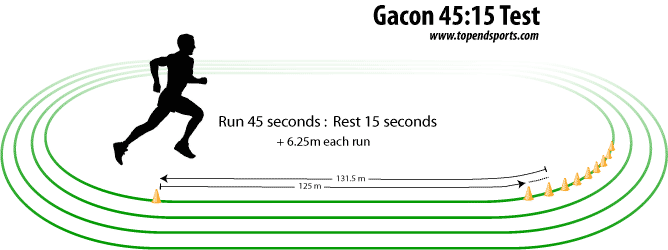The "Gacon test" was devised by professor Georges Gacon (in 1994), the French National Team Manager of middle-distance race runners from 1984 to 1994, and former fitness trainer with French football club Marseille plus others. It is another intermittent style test, with 45 seconds of running, with 15 seconds rest, with the running distance (and therefore the running speed) incrementally increasing. The test is mostly performed by soccer players in Europe. The test has been validated by Assadi and Lepers (2012). There is a similar 30-15 Intermittent Fitness Test (30-15 IFT) with 30 seconds efforts and 15 seconds rest.
test purpose: to measure intermittent running ability and aerobic fitness in soccer players
equipment required: oval or running track, measuring tape, marker cones, whistle, stopwatch.
pre-test: Explain the test procedures to the subject. Perform screening of health risks and obtain informed consent. Prepare forms and record basic information such as age, height, body weight, gender, test conditions. Measure and mark out the course. Ensure that the participants are adequately warmed-up. See more details of pre-test procedures.
course setup: Mark out a track with cones at the distance of 125m, 131.25m, 137.5m etc.

procedure: All participants line up at the starting line. Players are required to run 125 metres within 45 seconds. Upon completion, they are given 15 seconds to rest. When the 15 seconds are up, they repeat the run in the opposite direction back to the starting cone, but this time the distance is increased by 6.25m to 131.25m. For each repetition, the distance is increased by 6.25m while the running (45sec) and the rest time (15sec) remains constant (see table). The athletes continue until they are unable to cover the set distance in 45 seconds.
| Stage |
Distance (m) |
Avg. pace (min/km) |
Ave speed (km/hr) |
Total Distance (m) |
|---|---|---|---|---|
| 1 | 125 | 6:00 | 10 | 125 |
| 2 | 131.25 | 5:43 | 10.5 | 256.25 |
| 3 | 137.5 | 5:27 | 11 | 393.75 |
| 4 | 143.75 | 5:13 | 11.5 | 537.5 |
| 5 | 150 | 5:00 | 12 | 687.5 |
| 6 | 156.25 | 4:48 | 12.5 | 843.75 |
| 7 | 162.5 | 4:37 | 13 | 1006.25 |
| 8 | 168.75 | 4:27 | 13.5 | 1175 |
| 9 | 175 | 4:17 | 14 | 1350 |
| 10 | 181.25 | 4:08 | 14.5 | 1531.25 |
| 11 | 187.5 | 4:00 | 15 | 1718.75 |
| 12 | 193.75 | 3:52 | 15.5 | 1912.5 |
| 13 | 200 | 3:45 | 16 | 2112.5 |
| 14 | 206.25 | 3:38 | 16.5 | 2318.75 |
| 15 | 212.5 | 3:31 | 17 | 2531.25 |
| 16 | 218.75 | 3:26 | 17.5 | 2750 |
| 17 | 225 | 3:20 | 18 | 2975 |
| 18 | 231.25 | 3:15 | 18.5 | 3206.25 |
| 19 | 237.5 | 3:10 | 19 | 3443.75 |
| 20 | 243.75 | 3:05 | 19.5 | 3687.5 |
| 21 | 250 | 3:00 | 20 | 3937.5 |
| 22 | 256.25 | 2:56 | 20.5 | 4193.75 |
| 23 | 262.5 | 2:52 | 21 | 4456.25 |
| 24 | 268.75 | 2:48 | 21.5 | 4725 |
| 25 | 275 | 2:44 | 22 | 5000 |
scoring: The total distance covered (in meters) is recorded.
variations: The test can be modified for young and less fit athletes, with the first distance is only 100m, and increasing by 6.25m each stage from that.
advantages: large groups can be tested at once, and it is a very cheap and simple test to perform with minimal equipment.
reference:
- Castagna, C., Iellamo, F., Impellizzeri, F.M., and Manzi, V. Validity and reliability of the 45-15 test for aerobic fitness in young soccer players. Int. J. Sports. Physiol. Perform., 2013.
- Assadi, Hervé and Lepers, Romuald (2012) Comparison of the 45-Second/15-Second Intermittent Running Field Test and the Continuous Treadmill Test. International Journal of Sports Physiology and Performance, 2012, 7, 277-284. - The results suggested that the 45-15FIT is an accurate field test to determine VO2max and that MAV45-15 can be used during high-intensity intermittent training such as 30-s runs interspersed with 30-s rests (30-s/30-s) to elicit a high percentage of VO2max.
Similar Tests
- 30-15 Intermittent Fitness Test (30-15 IFT)
- Interval Shuttle Run Test (ISRT) — also with a 30/15 second work/rest ratio
- See also the Yo-Yo Intermittent Tests and the Loughborough Intermittent Shuttle Test which are shuttle tests designed for testing soccer players.
Related Pages
- Mauricio Pochettino and his beloved Gacon Test
- bout Testing for Intermittent Sports
- Beep Test Modifications


 Current Events
Current Events